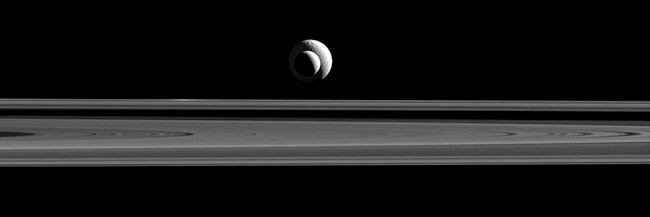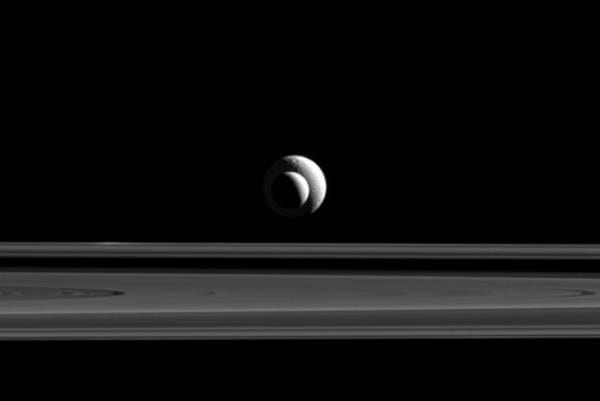Cassini Snaps Saturn’s Moon in Almost Perfect Alignment
 NASA/JPL-Caltech/Space Science Institute, Public domain, via Wikimedia Commons
NASA/JPL-Caltech/Space Science Institute, Public domain, via Wikimedia Commons
NASA’s Cassini spacecraft has been orbiting Saturn now for over a decade and has been the one responsible for snapping some incredible images. But on September 24th 2015, Cassini was at the “right place at exactly the right time” as we are now enjoying the photo of Saturn’s two moons, Enceladus and Tethys, in almost perfect alignment.
When Cassini took this amazing shot, the two moons were approximately 300,000 miles apart (500,000 kilometers) and Cassini was approximately 1.3 million miles (2.1 million kilometers) from Enceladus and 1.6 million miles (2.6 million kilometers) from Tethys — an amazingly impressive image considering the massive distance the spacecraft was dealing with.

NASA/JPL-Caltech/Space Science Institute, Public domain, via Wikimedia Commons
Credit: NASA/JPL-Caltech/Space Science InstituteSo why the interest in these moons?
Although, anything space-related is bound to capture the interest of astronomers and scientists, Enceladus is particularly spectacular as it is thought to possess the “ingredients for life.”
E-22 is almost here
Unfortunately, Cassini will be leaving the Saturn realm and is getting ready for its last ever flyby of Enceladus on December 19th. This is being called the E-22 (the 22nd flyby) in which Cassini will come within 3,106 miles (4,999 kilometers) of the moon’s surface. Oh what images we can expect from that exploration!
Fun Facts About Enceladus
Although Enceladus is Saturn’s tiny moon, this satellite contains a whole host of interesting and fun facts. Let’s discover some of what this little moon has to offer.
- Enceladus was discovered by Sir William Herschel on August 28th, 1789 by using a 1.2-meter telescope.
- This moon would be the first of two moons discovered by Herschel, and the sixth moon found orbiting Saturn.
- This tiny moon is very bright (90 percent of the sunlight falling upon it is reflected back from its icy surface).
- Since the sun is being reflected instead of absorbed, temperatures on this moon can dip down to minus 201 degrees Celsius (minus 330 degrees Fahrenheit).
- The glare from Saturn also hides the light from Enceladus.
- It only measures 314 miles (505 kilometers) in diameter and is the sixth largest moon of Saturn
- This moon is one-seventh the size of Earth’s moon
- Enceladus has at least five different types of terrain on its surface; craters (reaching sizes up to 22 miles (35 km) across), smooth and recently resurfaced areas, plains, fissures and also breaks in the crust.
Fun Facts About Tethys
Since Tethys is also involved in the alignment, let’s explore some fascinating and fun facts about this mid-size moon of the ringed planet.
- Tethys was discovered by G. D. Cassini in 1684 and is named after the titan Tethys of Greek mythology.
- For almost 200 years the moons of Saturn were numbered according to their distance from the planet; Tethys orbits at 183,100 miles (294,660 kilometers) so it was termed Saturn III.
- Tethys is made up almost entirely of water-ice. At average temperatures of minus 187 degrees Celsius (minus 305 degrees Fahrenheit).
- This moon has no atmosphere and always has one side pointed towards Saturn.
- Tethys measures in at 662 miles (1,066 kilometers) and about two-fifths of that is crater 250 miles (400 kilometers) across.
- The Ithaca Chasma is a trench that runs from the moon’s north pole to its south pole, extending 1,200 miles (2,000 km) — this means it spans nearly three-quarters of the planet’s circumference.
- One of Cassini’s photos revealed a Pac-Man like shape on the surface of this moon.
The wonders Cassini has revealed about Saturn and her moon’s has been truly enlightening. It’s too bad this spacecraft has to move on; however the wonders that lie ahead of its journey into the Universe is yet to be discovered. But whatever is revealed is sure to fascinate and astound our Earthly minds.
